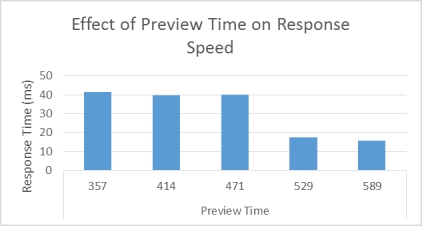Use the following to answer questions
Scenario I
Scenario I is based on fabricated data inspired by the following study:
Warner, C. B. & Jackson, J. D. (2009) . A time course examination of the preview effect: older adults need a longer preview than younger adults. Experimental Aging Research, 35, 327-347.
Preview Time and Aging
The purpose of this experiment was to determine the minimum preview time required for adults to make a fast perceptual decision. Young adults and older adults were presented visual stimuli for 357, 414, 471, 529 or 586 milliseconds (ms) . Knowing that older adults are more sensitive to cool temperatures, the researchers increased the temperature of the room to 75 degrees for the older adults (the temperature of the room for younger adults was 68 degrees) at the request of the IRB. The visual stimulus was presented on a computer monitor and contained several letter Ls rotated at various degrees. After the preview stimulus the participants were shown the test stimulus. This contained the Ls in the preview, as well as several additional Ls and one letter T. The participants were instructed to locate the "T" and were given 5.5 seconds to do so. This procedure was repeated several times such that each participant received 360 trials. The results indicated that younger adults located the T more quickly than the older adults regardless of preview time. Among the younger adults, preview time significantly affected their ability to locate the T. Specifically, they were more quickly able to identify the T when the preview time was 414 ms or 586 ms. The results indicate that preview time significantly affects perceptual discrimination and are illustrated in Figure 1.
 Figure 1. Participants responded significantly faster to visual stimuli when they were given 529 ms or 589 ms to preview the stimuli.
Figure 1. Participants responded significantly faster to visual stimuli when they were given 529 ms or 589 ms to preview the stimuli.
-(Scenario I) If there are 100 older adults and 100 younger adults in the study described in Scenario I, and adults in each age group are equally distributed across the five preview conditions, then there are _____ participants in each preview condition.
Definitions:
Wild Plant Foods
Edible plants that grow in natural, wild settings without human cultivation, often foraged for consumption.
Cultural Evolution
The theory that culture changes over time due to various factors such as innovation, diffusion, and social learning, somewhat analogous to biological evolution.
Notion Of Progress
The idea or belief that society, technology, the economy, and cultures are moving forward and improving over time.
Horticulturalists
Individuals or societies that specialize in the art and science of cultivating plants, especially fruits, vegetables, and ornamental plants.
Q16: Define and give an example of a
Q31: (Scenario I) Let's say you are skeptical
Q53: Dr. Nixon noted the following results:
Q68: Cronbach's alpha refers to:<br>A) the degree to
Q70: What is a cell mean?
Q76: Which of the following would be helpful
Q109: Dr. Watkins believes that a participant's anxiety
Q130: Dante used a public scale for an
Q132: Extra credit for participation in research studies
Q161: Dr. Nova had all participants transition among